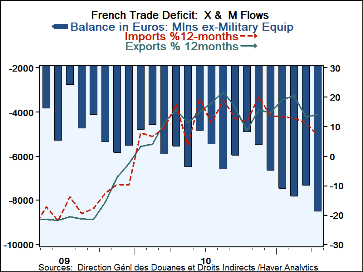 Global| Jun 14 2011
Global| Jun 14 2011French Trade Picture Erodes
Summary
The French trade picture is showing steady slippage. The trade deficit is eroding steadily. Exports have slowed sharply from their year ago growth rate of 17.7% to 7.2%; the sequential growth rates for exports are somewhat mixed but [...]
 The French trade picture is showing steady slippage. The trade deficit is eroding steadily. Exports have slowed sharply from
their year ago growth rate of 17.7% to 7.2%; the sequential growth rates for exports are somewhat mixed but the recent three month
rate of growth is quite weak and has sunk into a slight contraction.
The French trade picture is showing steady slippage. The trade deficit is eroding steadily. Exports have slowed sharply from
their year ago growth rate of 17.7% to 7.2%; the sequential growth rates for exports are somewhat mixed but the recent three month
rate of growth is quite weak and has sunk into a slight contraction.
French imports have slowed by less compared to their year ago rate of 15.6%. The current year-year growth rate is a nearly steady 14.0%. Sequential growth rates for French imports also are erratic but the recent three months show some deceleration to about a 10% annual rate. Imports clearly have been and continue to be outpacing imports.
The French imports data show continuing strength in foods with some slowing in transportation equipment and in other imports. For exports transportation flows have been contracting over the three-,six-, and twelve-month horizons. Other exports are slowing but French food exports are holding at a steady and strong rate of growth.
France offers year another view of the Euro-Area and its level of competitiveness. France is having less trade success than Germany and is showing somewhat better maintained domestic demand. Germany’s economy seems geared to re-fabricate goods for export. While the rising euro seems to have little impact on German trade France and the peripheral Zone countries are increasingly having difficulty maintaining their trade positions There is more tension in the Euro-Area than just over debt issues lending and ECB policy.
| French Trade Trends for Goods, Excl Military Equip | ||||||
|---|---|---|---|---|---|---|
| M/M% | % SAAR | |||||
| Apr-11 | Mar-11 | 3M | 6M | 12M | 12M ago | |
| Balance* | -€ 8,529.00 | -€ 7,364.00 | -€ 7,915.67 | -€ 7,248.00 | -€ 6,500.00 | -€ 4,905 |
| EXPORTS | ||||||
| All Exp | -1.7% | 1.4% | -0.3% | 11.9% | 7.2% | 17.7% |
| Food, Bev &Tobacco | 0.1% | 1.1% | 15.6% | 17.6% | 14.5% | 7.6% |
| Transport Equip | -1.5% | 2.3% | -6.1% | -3.4% | -3.1% | 28.8% |
| Other Exp | -2.1% | 1.2% | -0.6% | 16.3% | 9.7% | 15.8% |
| IMPORTS | ||||||
| All IMP | 1.4% | 0.0% | 9.9% | 31.7% | 14.0% | 15.6% |
| Food, Bev &Tobacco | 0.0% | 0.7% | 14.1% | 22.4% | 11.9% | 0.2% |
| Transport Equip | 6.1% | 3.0% | 9.6% | 24.2% | 18.1% | 5.9% |
| Other Imp | 0.6% | -0.6% | 9.6% | 34.0% | 13.4% | 19.2% |
| All data seasonally adjusted *Eur mlns; mo or period average | ||||||
Robert Brusca
AuthorMore in Author Profile »Robert A. Brusca is Chief Economist of Fact and Opinion Economics, a consulting firm he founded in Manhattan. He has been an economist on Wall Street for over 25 years. He has visited central banking and large institutional clients in over 30 countries in his career as an economist. Mr. Brusca was a Divisional Research Chief at the Federal Reserve Bank of NY (Chief of the International Financial markets Division), a Fed Watcher at Irving Trust and Chief Economist at Nikko Securities International. He is widely quoted and appears in various media. Mr. Brusca holds an MA and Ph.D. in economics from Michigan State University and a BA in Economics from the University of Michigan. His research pursues his strong interests in non aligned policy economics as well as international economics. FAO Economics’ research targets investors to assist them in making better investment decisions in stocks, bonds and in a variety of international assets. The company does not manage money and has no conflicts in giving economic advice.






